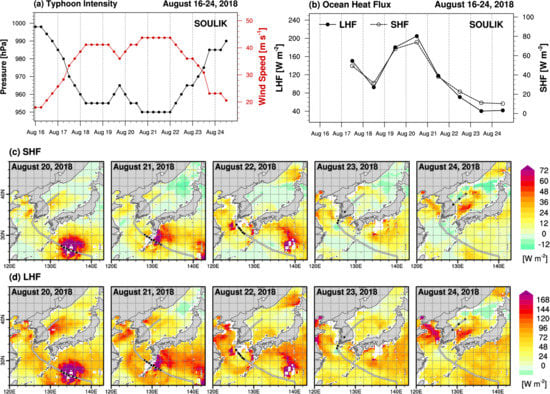Characteristics of Satellite-Based Ocean Turbulent Heat Flux around the Korean Peninsula and Relationship with Changes in Typhoon Intensity
Abstract
1. Introduction
2. Data
2.1. Satellite Data
2.2. Marine Buoy Data
2.3. Typhoons
3. Methods
3.1. Production of Air–Sea Variables
3.2. COARE 3.5 Bulk Algorithm
4. Results and Discussion
4.1. Evaluation of Satellite-Based Air–Sea Variables and Turbulent Heat Flux
4.2. Characteristics of Oceanic Turblent Heat Fluxes around the Korean Peninsula
4.3. Changes in Oceanic Turbulent Heat Flux During Typhoons
4.3.1. Typhoon Soulik (2018)
4.3.2. Typhoon Francisco (2019)
5. Summary and Conclusions
Author Contributions
Funding
Institutional Review Board Statement
Informed Consent Statement
Acknowledgments
Conflicts of Interest
References
- Rodgers, E.B.; Olson, W.S.; Karyampudi, V.M.; Pierce, H.F. Satellite-Derived Latent Heating Distribution and Environmental Influences in Hurricane Opal (1995). Mon. Weather Rev. 1998, 126, 19. [Google Scholar] [CrossRef]
- Bao, J.-W.; Wilczak, J.M.; Choi, J.-K.; Kantha, L.H. Numerical Simulations of Air–Sea Interaction under High Wind Conditions Using a Coupled Model: A Study of Hurricane Development. Mon. Weather Rev. 1986, 128, 2190–2210. [Google Scholar] [CrossRef]
- Li, W. Modelling air-sea fluxes during a western Pacific typhoon: Role of sea spray. Adv. Atmos. Sci. 2004, 21, 269–276. [Google Scholar] [CrossRef]
- Wu, L.; Wang, B.; Braun, S.A. Impacts of Air–Sea Interaction on Tropical Cyclone Track and Intensity. Mon. Weather Rev. 2005, 133, 3299–3314. [Google Scholar] [CrossRef]
- Chen, S.; Li, W.; Lu, Y.; Wen, Z. Variations of latent heat flux during tropical cyclones over the South China Sea: Variations of latent heat flux during tropical cyclones. Met. Apps. 2014, 21, 717–723. [Google Scholar] [CrossRef]
- Ma, Z.; Fei, J.; Huang, X.; Cheng, X. Contributions of Surface Sensible Heat Fluxes to Tropical Cyclone. Part I: Evolution of Tropical Cyclone Intensity and Structure. J. Atmos. Sci. 2015, 72, 120–140. [Google Scholar] [CrossRef]
- Ma, Z. Examining the contribution of surface sensible heat flux induced sensible heating to tropical cyclone intensification from the balance dynamics theory. Dyn. Atmos. Ocean. 2018, 84, 33–45. [Google Scholar] [CrossRef]
- Businger, J.A. Evaluation of the Accuracy with Which Dry Deposition Can Be Measured with Current Micrometeorological Techniques. J. Clim. Appl. Meteorol. 1986, 25, 1100–1124. [Google Scholar] [CrossRef]
- Mason, P. Atmospheric Boundary Layer Flows: Their Structure and Measurement; Kaimal, J.C., Finnigan, J.J., Eds.; Oxford University Press: Oxford, UK, 1993. [Google Scholar]
- Gleckler, P.J.; Weare, B.C. Uncertainties in Global Ocean Surface Heat Flux Climatologies Derived from Ship Observations. J. Cimate 1997, 10, 18. [Google Scholar] [CrossRef]
- Kondo, J. Air-sea bulk transfer coefficients in diabatic conditions. Bound. Layer Meteorol. 1975, 9, 91–112. [Google Scholar] [CrossRef]
- Fairall, C.W.; Bradley, E.F.; Hare, J.E.; Grachev, A.A.; Edson, J.B. Bulk Parameterization of Air–Sea Fluxes: Updates and Verification for the COARE Algorithm. J. Clim. 2003, 16, 21. [Google Scholar] [CrossRef]
- Kubota, M.; Iwasaka, N.; Kizu, S.; Konda, M.; Kutsuwada, K. Japanese Ocean Flux Data Sets with Use of Remote Sensing Observations (J-OFURO). J. Oceanogr. 2002, 58, 213–225. [Google Scholar] [CrossRef]
- Chou, S.-H.; Nelkin, E.; Ardizzone, J. Surface Turbulent Heat and Momentum Fluxes over Global Oceans Based on the Goddard Satellite Retrievals, Version 2 (GSSTF2). J. Clim. 2003, 16, 18. [Google Scholar] [CrossRef]
- Shie, C.-L.; Chiu, L.S.; Adler, R.; Nelkin, E.; Lin, I.-I.; Xie, P.; Wang, F.-C.; Chokngamwong, R.; Olson, W.; Chu, D.A. A note on reviving the Goddard Satellite-based Surface Turbulent Fluxes (GSSTF) dataset. Adv. Atmos. Sci. 2009, 26, 1071–1080. [Google Scholar] [CrossRef]
- Yu, L.; Jin, X.; Weller, R. Multidecade Global Flux Datasets from the Objectively Analyzed Air-Sea Fluxes (OAFlux) Project: Latent and Sensible Heat Fluxes, Ocean Evaporation, and Related Surface Meteorological Variables; OAFlux Project Technical Report, OA-2008-01; Woods Hole Oceanographic Institution: Woods Hole, MA, USA, 2008; 64p. [Google Scholar]
- Andersson, A.; Fennig, K.; Klepp, C.; Bakan, S.; Graßl, H.; Schulz, J. The Hamburg Ocean Atmosphere Parameters and Fluxes from Satellite Data—HOAPS-3. Earth Syst. Sci. Data 2010, 2, 215–234. [Google Scholar] [CrossRef]
- Praveen Kumar, B.; Vialard, J.; Lengaigne, M.; Murty, V.S.N.; McPhaden, M.J. TropFlux: Air-sea fluxes for the global tropical oceans—Description and evaluation. Clim. Dyn. 2012, 38, 1521–1543. [Google Scholar] [CrossRef]
- Bourras, D. Comparison of Five Satellite-Derived Latent Heat Flux Products to Moored Buoy Data. J. Clim. 2006, 19, 6291–6313. [Google Scholar] [CrossRef]
- Chu, P.; Yuchun, C.; Kuninaka, A. Seasonal variability of the Yellow Sea/East China Sea surface fluxes and thermohaline structure. Adv. Atmos. Sci. 2005, 22, 1–20. [Google Scholar] [CrossRef]
- Emanuel, K.A. An Air-Sea Interaction Theory for Tropical Cyclones. Part I: Steady-State Maintenance. J. Atmos. Sci. 1986, 43, 585–605. [Google Scholar] [CrossRef]
- Jaimes, B.; Shay, L.K.; Uhlhorn, E.W. Enthalpy and Momentum Fluxes during Hurricane Earl Relative to Underlying Ocean Features. Mon. Wea. Rev. 2015, 143, 111–131. [Google Scholar] [CrossRef]
- Potter, H.; Drennan, W.M.; Graber, H.C. Upper ocean cooling and air-sea fluxes under typhoons: A case study. J. Geophys. Res. Ocean. 2017, 122, 9. [Google Scholar] [CrossRef]
- Wentz, F.J.; Meissner, T.; Gentemann, C.; Hilburn, K.A.; Scott, J. Remote Sensing Systems GCOM-W1 AMSR2 Daily Environmental Suite on 0.25 Deg Grid; Version 8.0; Remote Sensing Systems: Santa Rosa, CA, USA, 2014. [Google Scholar]
- Wentz, F.J.; Meissner, T.; Scott, J.; Hilburn, K.A. Remote Sensing Systems GPM GMI Daily Environmental Suite on 0.25 Deg Grid; Version 8.2; Remote Sensing Systems: Santa Rosa, CA, USA, 2015. [Google Scholar]
- Wentz, F.J.; Ricciardulli, L.; Gentemann, C.; Meissner, T.; Hilburn, K.A.; Scott, J. Remote Sensing Systems Coriolis WindSat Daily Environmental Suite on 0.25 Deg Grid; Version 7.0.1; Remote Sensing Systems: Santa Rosa, CA, 2013. [Google Scholar]
- Wentz, F.J.; Hilburn, K.A.; Smith, D.K. Remote Sensing Systems DMSP SSMIS Daily Environmental Suite on 0.25 Deg Grid; Version 8; Remote Sensing Systems: Santa Rosa, CA, USA, 2012. [Google Scholar]
- Park, J.; Yeo, D.; Lee, K.; Lee, H.; Lee, S.; Noh, S.; Kim, S.; Shin, J.; Choi, Y.; Nam, S. Rapid Decay of Slowly Moving Typhoon Soulik (2018) due to Interactions with the Strongly Stratified Northern East China Sea. Geophys. Res. Lett. 2019, 46, 14595–14603. [Google Scholar] [CrossRef]
- Kara, A.B.; Wallcraft, A.J.; Bourassa, M.A. Air-sea stability effects on the 10 m winds over the global ocean: Evaluations of air-sea flux algorithms. J. Geophys. Res. 2008, 113, C04009. [Google Scholar] [CrossRef]
- Liu, W.T. Statistical Relation between Monthly Mean Precipitable Water and Surface-Level Humidity over Global Oceans. Mon. Weather Rev. 1986, 114, 1591–1602. [Google Scholar] [CrossRef]
- Hsu, S.A.; Blanchard, B.W. The relationship between total precipitable water and surface-level humidity over the sea surface: A further evaluation. J. Geophys. Res. 1989, 94, 14539. [Google Scholar] [CrossRef]
- Schulz, J.; Schluessel, P.; Grassl, H. Water vapour in the atmospheric boundary layer over oceans from SSM/I measurements. Int. J. Remote Sens. 1993, 14, 2773–2789. [Google Scholar] [CrossRef]
- Ruckstuhl, C.; Philipona, R.; Morland, J.; Ohmura, A. Observed relationship between surface specific humidity, integrated water vapor, and longwave downward radiation at different altitudes. J. Geophys. Res. 2007, 112, D03302. [Google Scholar] [CrossRef]
- Bentamy, A.; Grodsky, S.A.; Katsaros, K.; Mestas-Nuñez, A.M.; Blanke, B.; Desbiolles, F. Improvement in air–sea flux estimates derived from satellite observations. Int. J. Remote Sens. 2013, 34, 5243–5261. [Google Scholar] [CrossRef]
- Kim, J.; Lee, Y.G.; Park, J.D.; Sohn, E.H.; Jang, J.-D. Calculation and Monthly Characteristics of Satellite-based Heat Flux Over the Ocean Around the Korea Peninsula. Korean J. Remote Sens. 2018, 34, 519–533. [Google Scholar] [CrossRef]
- Hong, G.-M.; Kwon, B.-H.; Han, Y.-H.; Kim, Y.-S. Estimation of marine meteorological parameters from the satellite data. Int. Geosci. Remote Sens. 2003, 4, 2254–2256. [Google Scholar] [CrossRef]
- Brunke, M.A.; Fairall, C.W.; Zeng, X.; Eymard, L.; Curry, J.A. Which Bulk Aerodynamic Algorithms are Least Problematic in Computing Ocean Surface Turbulent Fluxes? J. Clim. 2003, 16, 17. [Google Scholar] [CrossRef]
- Edson, J.B.; Jampana, V.; Weller, R.A.; Bigorre, S.P.; Plueddemann, A.J.; Fairall, C.W.; Miller, S.D.; Mahrt, L.; Vickers, D.; Hersbach, H. On the Exchange of Momentum over the Open Ocean. J. Phys. Oceanogr. 2013, 43, 1589–1610. [Google Scholar] [CrossRef]
- Zhou, F.; Zhang, R.; Shi, R.; Chen, J.; He, Y.; Wang, D.; Xie, Q. Evaluation of OAFlux datasets based on in situ air–sea flux tower observations over Yongxing Island in 2016. Atmos. Meas. Tech. 2018, 11, 6091–6106. [Google Scholar] [CrossRef]
- Sim, J.-E.; Shin, H.-R.; Hirose, N. Comparative Analysis of Surface Heat Fluxes in the East Asian Marginal Seas and Its Acquired Combination Data. J. Korean Earth Sci. Soc. 2018, 39, 1–22. [Google Scholar] [CrossRef]
- Oh, S.-Y.; Jang, S.-W.; Kim, D.-H.; Yoon, H.-J. Temporal and Spatial Variations of SL/SST in the Korean Peninsula by Remote Sensing. J. Fish. Mar. Sci. Educ. 2012, 24, 333–345. [Google Scholar] [CrossRef]
- Oh, H.M.; Ha, K.J.; Shim, J.S.; Hyun, Y.K.; Yun, K.S. Seasonal characteristics of turbulent fluxes observed at Ieodo Ocean Research Station. Atmosphere 2007, 17, 421–433. [Google Scholar]
- Dong, S.; Gille, S.T.; Sprintall, J.; Gentemann, C. Validation of the Advanced Microwave Scanning Radiometer for the Earth Observing System (AMSR-E) sea surface temperature in the Southern Ocean. J. Geophys. Res. 2006, 111, C04002. [Google Scholar] [CrossRef]
- Gentemann, C.L.; Wentz, F.J. Satellite Microwave SST: Accuracy, Comparisons to AVHRR and Reynolds SST, and Measurement of Diurnal Thermocline Variability. In Proceedings of the IEEE 2001 International Geoscience and Remote Sensing Symposium, Sydney, Australia, 9–13 July 2001; pp. 246–248. [Google Scholar] [CrossRef]
- Fujiwara, K.; Kawamura, R.; Kawano, T. Remote Thermodynamic Impact of the Kuroshio Current on a Developing Tropical Cyclone Over the Western North Pacific in Boreal Fall. J. Geophys. Res. Atmos. 2020, 125. [Google Scholar] [CrossRef]
- Hirose, N.; Lee, H.-C.; Yoon, J.-H. Surface Heat Flux in the East China Sea and the Yellow Sea. J. Phys. Oceanogr. 1999, 29, 17. [Google Scholar] [CrossRef]
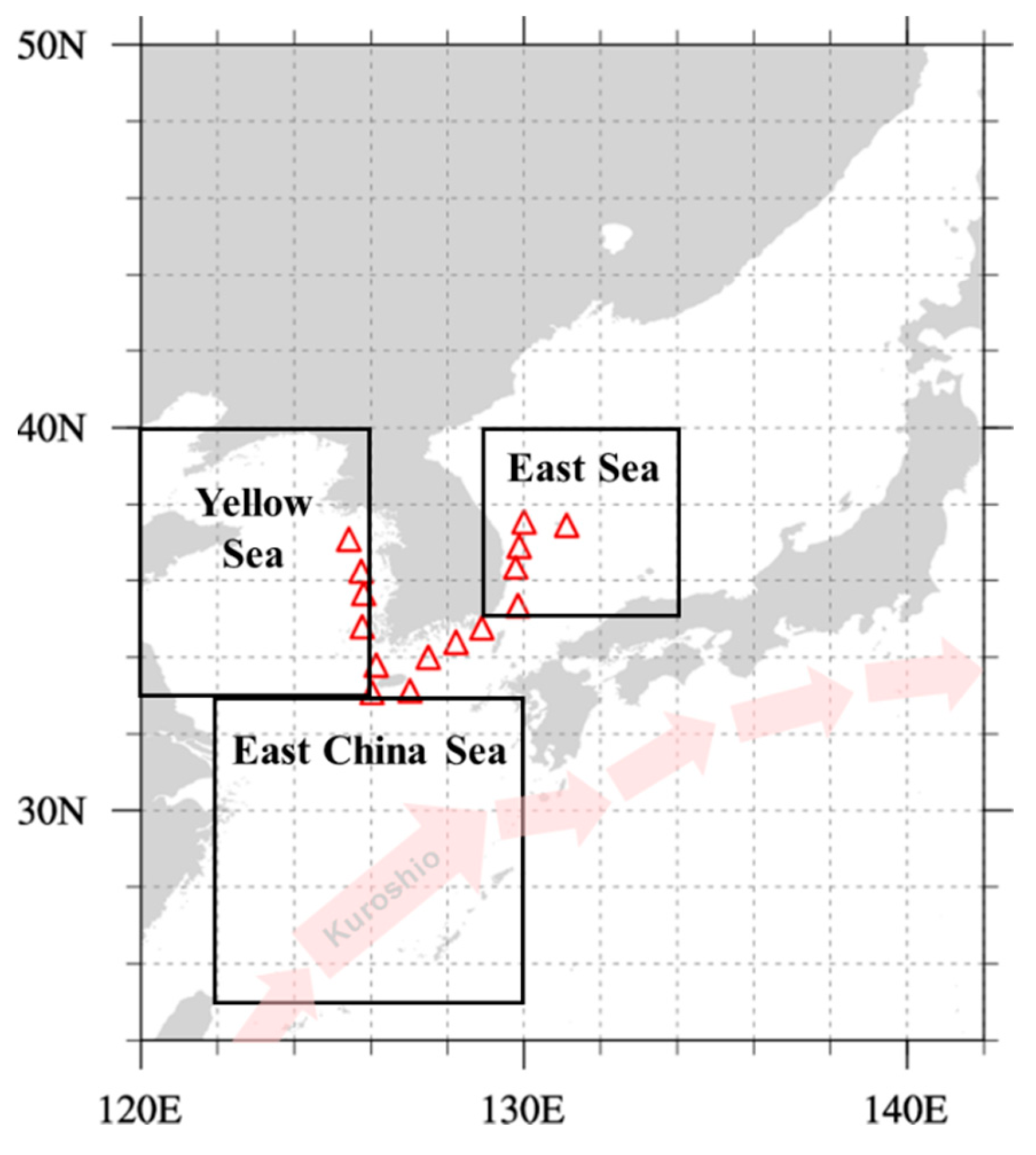
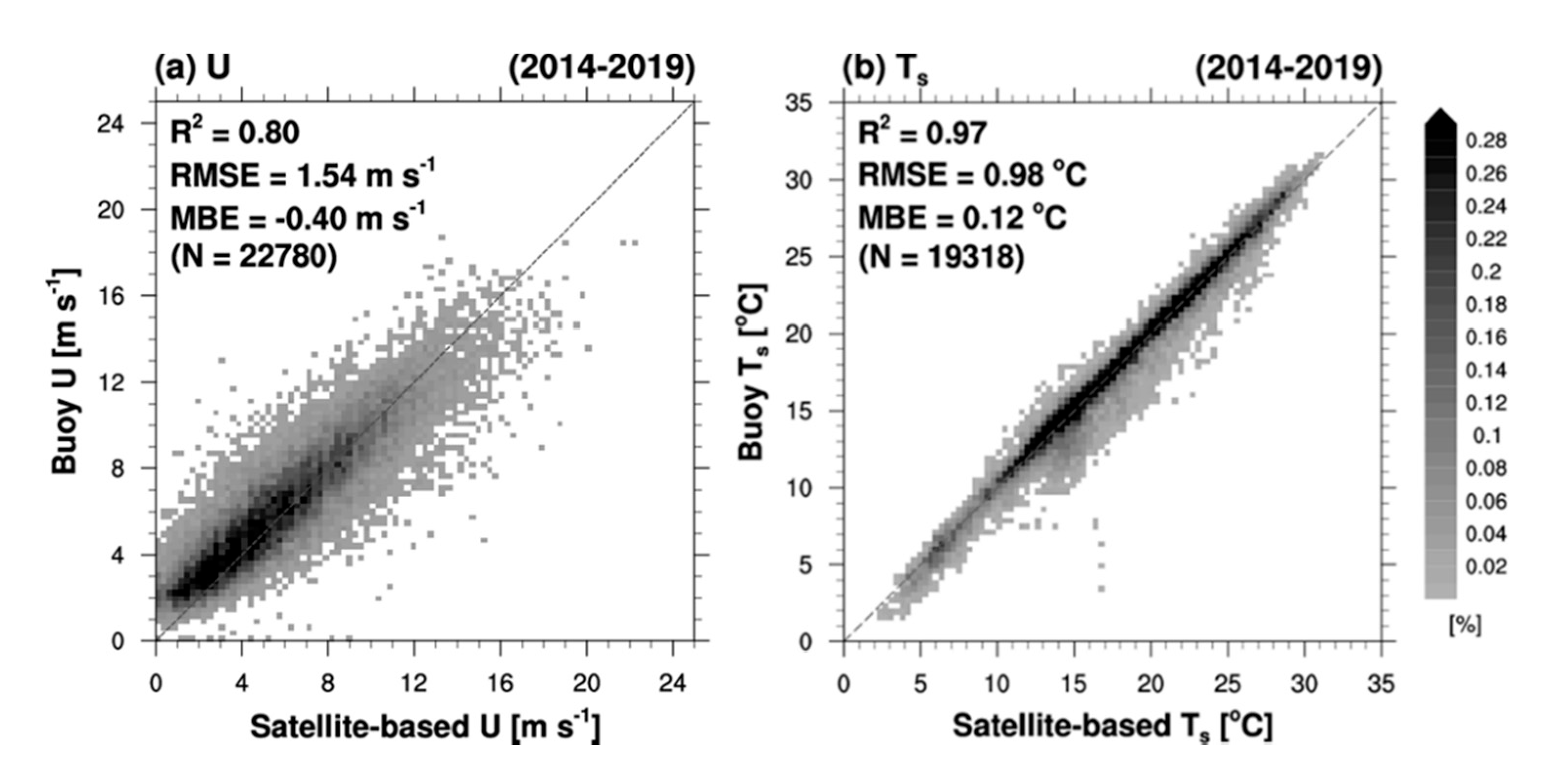
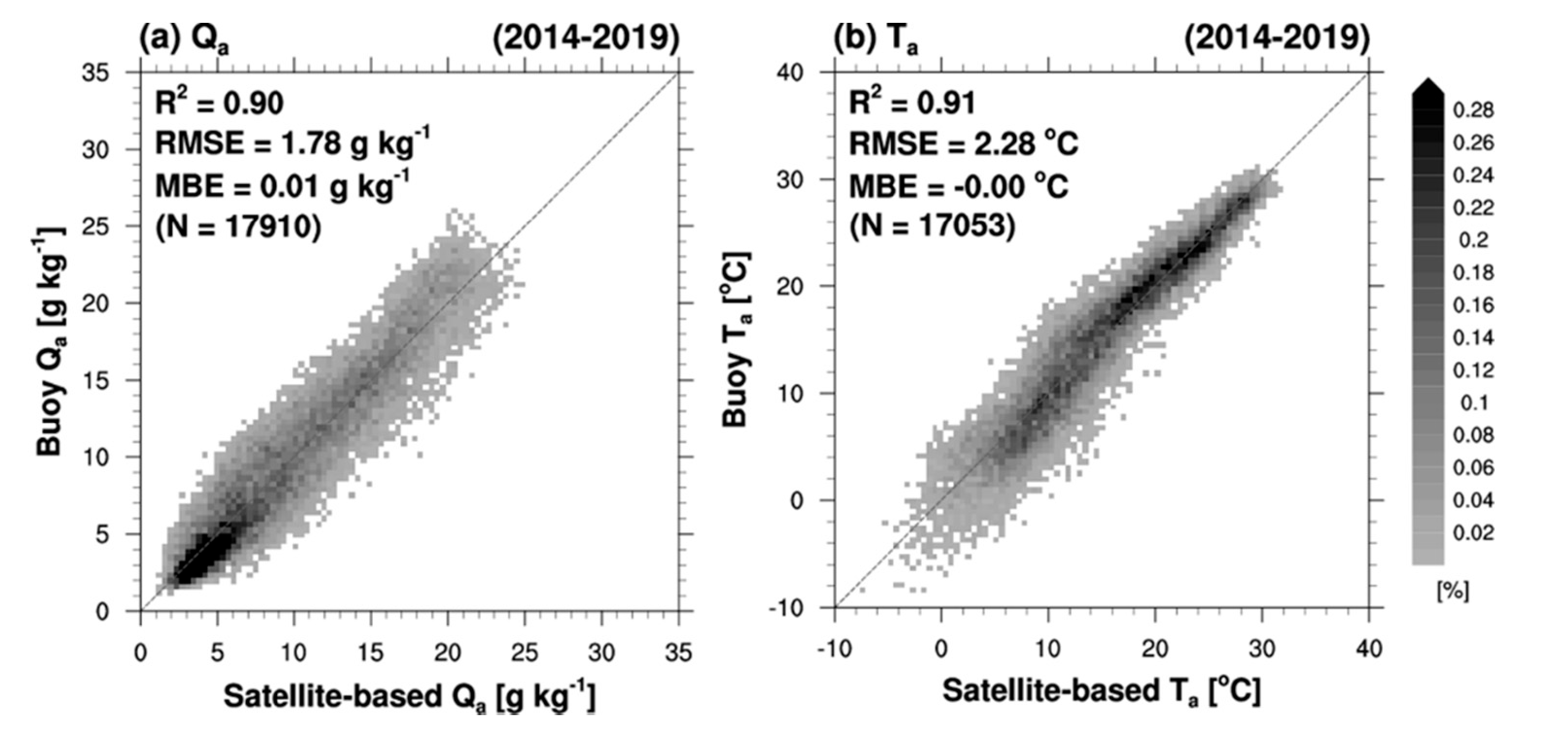
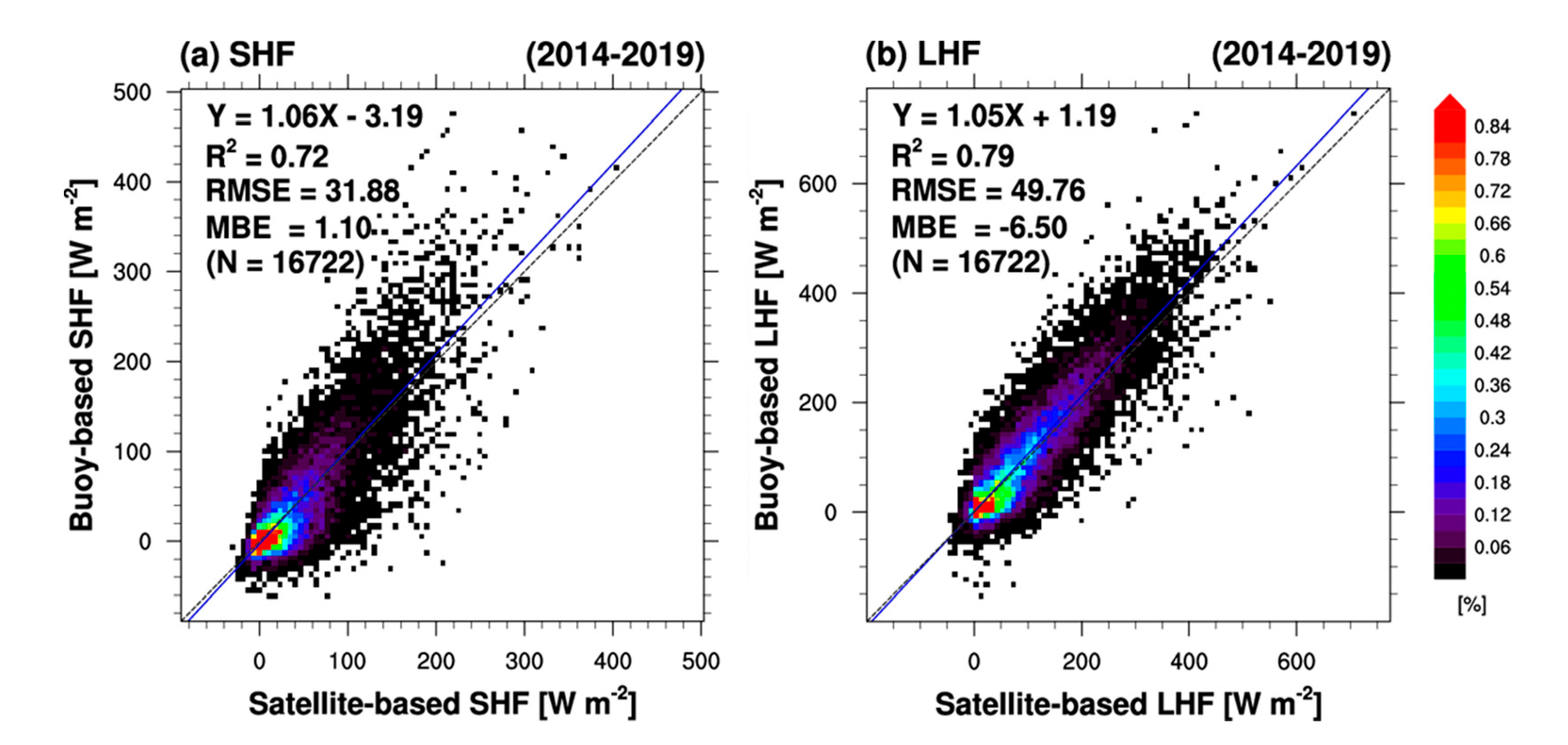

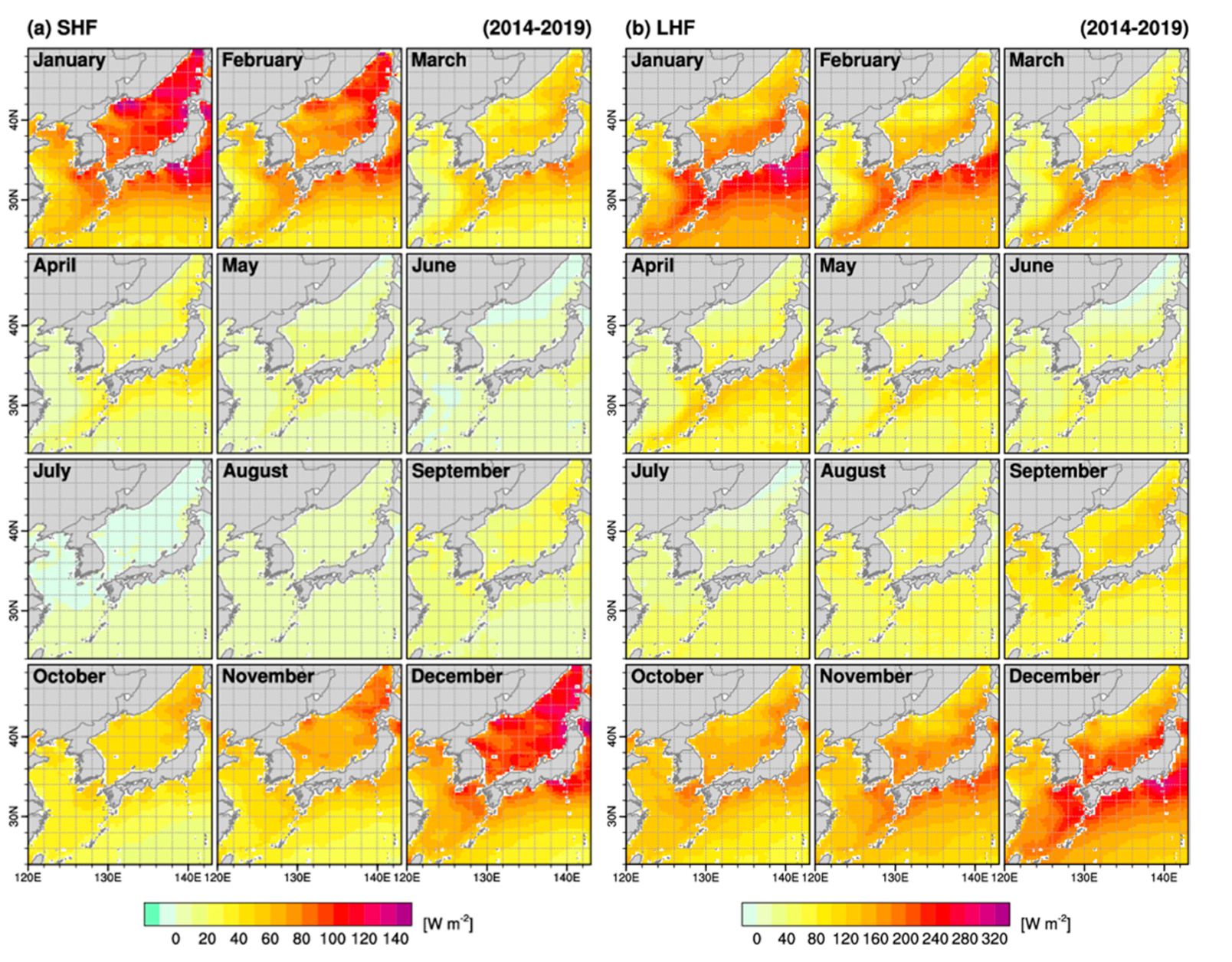

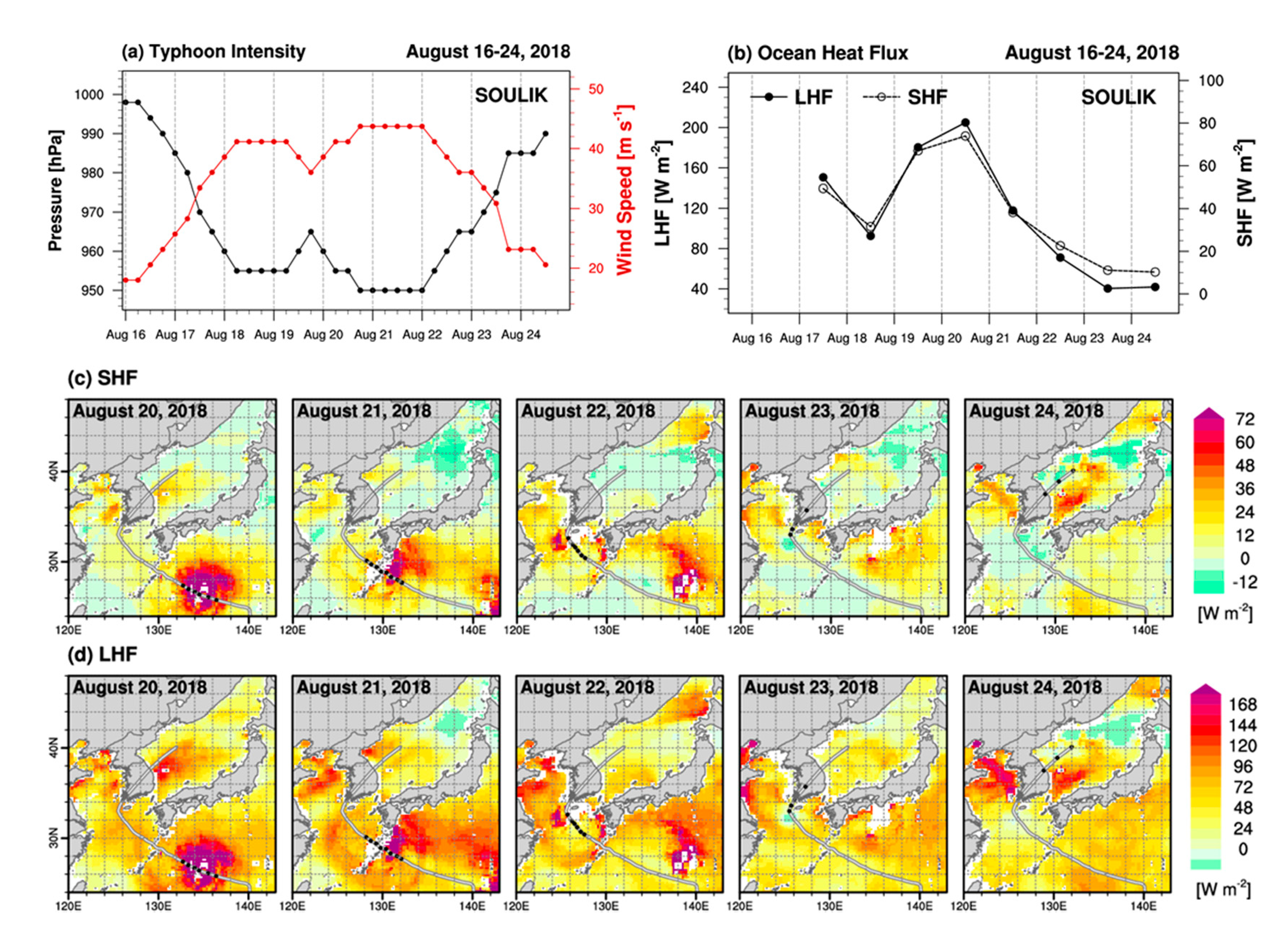

| Equation (1) | ||||
| a | b | c | d | e |
| 4.209 | −0.543 | 0.030 | 0.122 | 0.291 |
| Equation (2) | ||||
| a | b | c | d | |
| 0.752 | 3.919 | −0.315 | 1.949 | |
| Season | U (m s−1) | T s(°C) | Q a(g kg−1) | T a(°C) | SHF (W m−2) | LHF (W m−2) | |
|---|---|---|---|---|---|---|---|
| RMSE | Spring | 1.77 | 0.93 | 1.89 | 2.52 | 28.70 | 41.12 |
| Summer | 1.41 | 0.95 | 1.98 | 1.43 | 12.71 | 41.25 | |
| Autumn | 1.36 | 0.76 | 1.83 | 1.93 | 28.39 | 59.39 | |
| Winter | 1.56 | 1.24 | 1.33 | 2.89 | 47.48 | 55.23 | |
| Total | 1.54 | 0.98 | 1.78 | 2.28 | 31.88 | 49.76 | |
| MBE | Spring | −0.97 | 0.10 | −0.67 | −1.21 | 13.39 | 10.04 |
| Summer | −0.74 | 0.03 | −0.72 | 0.08 | 3.00 | 4.26 | |
| Autumn | 0.12 | 0.03 | 0.69 | −0.45 | 7.86 | −16.43 | |
| Winter | 0.01 | 0.30 | 0.80 | 1.58 | −19.87 | −24.72 | |
| Total | −0.40 | 0.12 | 0.01 | 0.00 | 1.10 | −6.50 |
| Month | SHF (W m−2) | LHF (W m−2) | ||||
|---|---|---|---|---|---|---|
| YS | ES | ECS | YS | ES | ECS | |
| January | 57.1 | 87.2 | 60.6 | 104.8 | 161.8 | 172.2 |
| February | 44.1 | 69.7 | 50.9 | 77.4 | 126.0 | 142.9 |
| March | 24.8 | 44.4 | 34.1 | 50.6 | 90.4 | 107.6 |
| April | 7.1 | 21.5 | 15.6 | 25.7 | 60.1 | 70.1 |
| May | 6.0 | 13.9 | 8.0 | 34.3 | 55.2 | 56.6 |
| June | 1.9 | 4.7 | 2.1 | 34.5 | 42.0 | 44.5 |
| July | −1.4 | −0.4 | 2.8 | 28.1 | 28.2 | 45.9 |
| August | 5.6 | 6.4 | 5.5 | 56.6 | 57.5 | 54.7 |
| September | 17.3 | 20.1 | 12.5 | 94.7 | 99.6 | 73.8 |
| October | 36.5 | 44.3 | 33.5 | 132.8 | 149.3 | 131.8 |
| November | 44.5 | 64.7 | 40.1 | 127.4 | 171.0 | 145.3 |
| December | 62.6 | 93.3 | 63.0 | 133.9 | 192.1 | 188.1 |
| Annual mean | 25.5 | 39.2 | 27.4 | 75.1 | 102.8 | 102.8 |
Publisher’s Note: MDPI stays neutral with regard to jurisdictional claims in published maps and institutional affiliations. |
© 2020 by the authors. Licensee MDPI, Basel, Switzerland. This article is an open access article distributed under the terms and conditions of the Creative Commons Attribution (CC BY) license (http://creativecommons.org/licenses/by/4.0/).
Share and Cite
Kim, J.; Lee, Y.G. Characteristics of Satellite-Based Ocean Turbulent Heat Flux around the Korean Peninsula and Relationship with Changes in Typhoon Intensity. Remote Sens. 2021, 13, 42. https://doi.org/10.3390/rs13010042
Kim J, Lee YG. Characteristics of Satellite-Based Ocean Turbulent Heat Flux around the Korean Peninsula and Relationship with Changes in Typhoon Intensity. Remote Sensing. 2021; 13(1):42. https://doi.org/10.3390/rs13010042
Chicago/Turabian StyleKim, Jaemin, and Yun Gon Lee. 2021. "Characteristics of Satellite-Based Ocean Turbulent Heat Flux around the Korean Peninsula and Relationship with Changes in Typhoon Intensity" Remote Sensing 13, no. 1: 42. https://doi.org/10.3390/rs13010042
APA StyleKim, J., & Lee, Y. G. (2021). Characteristics of Satellite-Based Ocean Turbulent Heat Flux around the Korean Peninsula and Relationship with Changes in Typhoon Intensity. Remote Sensing, 13(1), 42. https://doi.org/10.3390/rs13010042




